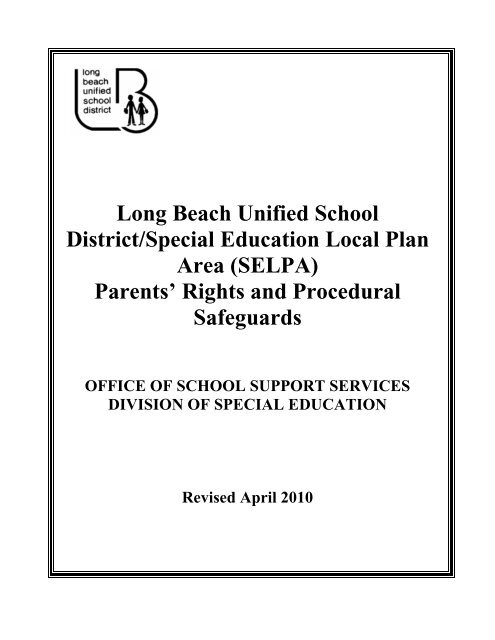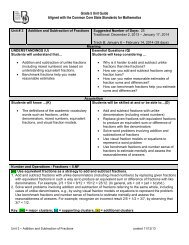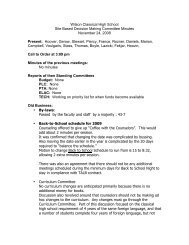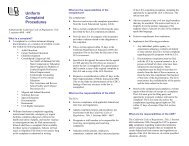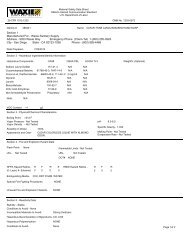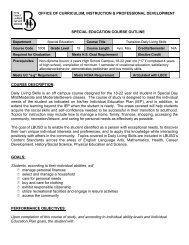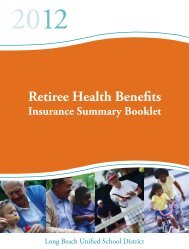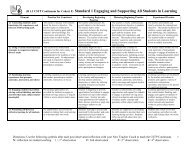Parents' Rights and Procedural Safeguards - Long Beach Unified ...
Parents' Rights and Procedural Safeguards - Long Beach Unified ...
Parents' Rights and Procedural Safeguards - Long Beach Unified ...
Create successful ePaper yourself
Turn your PDF publications into a flip-book with our unique Google optimized e-Paper software.
<strong>Long</strong> <strong>Beach</strong> <strong>Unified</strong> SchoolDistrict/Special Education Local PlanArea (SELPA)Parents’ <strong>Rights</strong> <strong>and</strong> <strong>Procedural</strong><strong>Safeguards</strong>OFFICE OF SCHOOL SUPPORT SERVICESDIVISION OF SPECIAL EDUCATIONRevised April 2010
The <strong>Long</strong> <strong>Beach</strong> <strong>Unified</strong> School District/SELPAParents’ <strong>Rights</strong> <strong>and</strong> <strong>Procedural</strong> <strong>Safeguards</strong>Compliance OfficerConnie L. JensenAssistant SuperintendentOffice of School Support ServicesDivision of Special Education1515 Hughes Way<strong>Long</strong> <strong>Beach</strong>, CA 90810Telephone: (562) 997-8644Director of Special EducationParisima Shahidi1515 Hughes Way<strong>Long</strong> <strong>Beach</strong>, CA 90810Telephone: (562) 997-8051Custodian of RecordsRichard M. TebbanoDistrict Administrator2221 Argonne Ave.<strong>Long</strong> <strong>Beach</strong>, CA 90815Telephone: (562) 986-6870 X 240Board of Education Members:Jon Meyer, PresidentMary Stanton, Vice-PresidentFelton Williams, MemberDavid Barton, MemberMichael Ellis, MemberSuperintendent of Schools:Christopher SteinhauserRevised April 2010GLASS rights-Eng.doc2C:\Documents <strong>and</strong> Settings\ARIVERS\Desktop\4-09 Revision modified
Table of ContentsDefinition 4Educational Record 5Independent Educational Evaluation 7Prior Written Notice 8Parental Consent 8Revocation of Consent 8Complaint Procedures 9Alternative Dispute Resolution 9Mediation 10Due Process 11Attorney’s Fees 13Disciplinary Actions 13Interim Alternative Educational Setting 14Unilateral Private Placements 15State Special Schools 15Surrogate Parents 15Revised April 2010GLASS rights-Eng.doc3C:\Documents <strong>and</strong> Settings\ARIVERS\Desktop\4-09 Revision modified
Dear Parent(s)/Guardian(s)/Pupil:This notice is provided to you because your child is being considered for possible placement or iscurrently enrolled in a special education program. This notice is also provided for children who areentitled to these rights at age 18. If your child is being referred for special education <strong>and</strong> all options of thegeneral education program have been considered, <strong>and</strong> where appropriate utilized, for your child, you havethe right to initiate a referral for special education.In California, special education is provided to children with disabilities between birth <strong>and</strong> twenty-oneyears of age. Federal <strong>and</strong> state laws protect you <strong>and</strong> your child throughout the procedures for evaluation<strong>and</strong> identification of special education placement <strong>and</strong> services. Parents of children with disabilities havethe right to participate in the individual education program process <strong>and</strong> be informed of the availability ofa free appropriate public education <strong>and</strong> of all available alternative programs, including public <strong>and</strong>nonpublic programs.You have the right to receive this notice in your primary/native language or other mode of communication(i.e., sign language or Braille), unless it is clearly not feasible to do so. These rights may also betranslated orally to you if your primary/native language is not a written language. This notice will begiven to you only one time a year, or upon: (1) your request; (2) the initial referral of your child for aspecial education evaluation; (3) reevaluation of your child; (4) removal of your child for violating aschool code of conduct that constitutes a change in placement; (5) filing of a state complaint; <strong>and</strong> (6)receipt of a request for a due process hearing. A copy of these procedural safeguards is also accessible onthe district’s website.The definitions below will help you underst<strong>and</strong> the statement of rights. Should you need furtherinformation regarding the contents or use of this guide, you may contact the Special Education Director,whose telephone number is on the second page of this document.DefinitionsChildren with Disabilities: The Individuals with Disabilities Education Act ("IDEA") defines “childrenwith disabilities” as including children with mental retardation, hearing impairments including deafness,speech or language impairments, visual impairments including blindness, emotional disturbance,orthopedic impairments, autism, traumatic brain injury, other health impairments or specific learningdisabilities, <strong>and</strong> who by reason thereof, need special education <strong>and</strong> related services.Consent: Consent means that: (1) parents have been given all information, in their native language orother mode of communication, that is relevant to any activity for which their consent is sought; (2)parents underst<strong>and</strong> <strong>and</strong> agree in writing to that activity, <strong>and</strong> the consent form they sign contains adescription of the activity <strong>and</strong> a list of records that will be released <strong>and</strong> to whom the records will bereleased in order to initiate or implement the activity; <strong>and</strong> (3) parents underst<strong>and</strong> that their consent isvoluntary <strong>and</strong> may be revoked at any time; however, their withdrawal of consent does not negate anaction that has already occurred.Evaluation: An assessment of your child using various tests <strong>and</strong> measures per Education Code section56320-56339 <strong>and</strong> 20 U.S.C. section 1414 (a), (b) <strong>and</strong> (c) to determine whether your child has a disability<strong>and</strong> the nature <strong>and</strong> extent of special <strong>and</strong> related services needed by your child for his/her educationalbenefit. The assessment tools are individually selected for your child <strong>and</strong> are administered by competentprofessionals employed by the local education agency. Testing <strong>and</strong> evaluation materials <strong>and</strong> procedureswill be selected <strong>and</strong> administered so as not to be racially, culturally, or sexually discriminatory. Thematerials or procedures will be provided <strong>and</strong> administered in your child’s native language or mode ofcommunication,Revised April 2010GLASS rights-Eng.doc4C:\Documents <strong>and</strong> Settings\ARIVERS\Desktop\4-09 Revision modified
unless it clearly is not feasible to do so. No single procedure shall be the sole criterion for determining anappropriate educational program for a child.Free Appropriate Public Education ("FAPE"): An education that: (1) is provided at public expense,under public supervision <strong>and</strong> direction, <strong>and</strong> without charge to you; (2) meets the st<strong>and</strong>ards of theCalifornia Department of Education; <strong>and</strong> (3) is provided in conformity with a written individualizededucation program developed for your child to confer an educational benefit <strong>and</strong> to be implemented in apreschool, elementary or secondary school program.Individual Education Program ("IEP"): A written document developed by your child's IEP team thatincludes at least all of the following: (1) present levels of academic achievement <strong>and</strong> functionalperformance; (2) measurable annual goals; (3) a statement of the special educational <strong>and</strong> related services<strong>and</strong> supplementary aids <strong>and</strong> services, based on peer-reviewed research to the extent practicable, to beprovided to the child; (4) an explanation of the extent to which the child will not participate with nondisabledchildren in the general education programs; (5) the projected date for initiation <strong>and</strong> theanticipated duration, frequency <strong>and</strong> location of the programs <strong>and</strong> services included in the IEP; <strong>and</strong> (6)appropriate objective criteria, evaluation procedures, <strong>and</strong> schedules for determining, on at least an annualbasis, whether the child is achieving his or her goals.Least Restrictive Environment ("LRE"): To the maximum extent appropriate, children with disabilitieswill be educated with children who are not disabled. Placement in special classes, separate schools, orother removal of children with disabilities from the general education program will occur only when thenature or severity of the disability is such that education in regular classes with the use of supplementaryaids <strong>and</strong> services cannot be achieved satisfactorily.Local Educational Agency ("LEA"): This term includes a school district, County Office of Education("COE"), a Special Education Local Plan Area ("SELPA"), or a charter school participating as a memberof a SELPA.Notification of Majority <strong>Rights</strong>: Your child has the right to receive all information about his/hereducational program <strong>and</strong> to make all decisions when he/she reaches the age of eighteen unless determinedincompetent by state law <strong>and</strong> procedures. Non-conserved adults are presumed, under the laws of the Stateof California, to be competent.Parent: The definition of parent includes: (1) person having legal custody of a child; (2) an adult studentfor whom no guardian or conservator has been appointed; (3) a person acting in place of a natural oradoptive parent, including a gr<strong>and</strong>parent, stepparent, or other relative with whom the child lives; (4) aparent surrogate; <strong>and</strong> (5) a foster parent, if the authority of a natural parent to make education decisionson the child’s behalf has been specifically limited by court order.When may I access Educational Records, <strong>and</strong> how do I do so?All parents or guardians of children enrolled in California public schools have the right to inspect recordsunder the Family Educational <strong>Rights</strong> <strong>and</strong> Privacy Act ("FERPA"), which has been implemented in theCalifornia Education Code.Educational records are those records that are directly related to your child <strong>and</strong> maintained by a schooldistrict, agency, or institution that collects, maintains, or uses personally identifiable information, or fromwhich information is obtained. Both federal <strong>and</strong> state laws further define an educational record as anyitem of information directly related to an identifiable pupil, other than directory information, which ismaintained by a school LEA, or required to be maintained by an employee in the performance of hisduties whether recorded by h<strong>and</strong>writing, print, tapes, film, microfilm, computer or by other means.Educational records do not include informal personal notes prepared <strong>and</strong> kept by a school employee forRevised April 2010GLASS rights-Eng.doc5C:\Documents <strong>and</strong> Settings\ARIVERS\Desktop\4-09 Revision modified
his/her own use or the use of a substitute. If records contain information about more than one child, youhave access only to that portion of the record pertaining to your child.Personally identifiable information may include: (1) the name of the child, the child’s parent or otherfamily member; (2) the address of the child; (3) a personal identifier such as the child’s social securitynumber, student number, or court file number; (4) a list of personal characteristics or other informationthat would make it possible to identify the child with a reasonable certainty.Additionally, parents of a child with disabilities, including non-custodial parents whose educational rightshave not been limited, are presumed to have the right to: (1) review all educational records regarding theidentification, evaluation, <strong>and</strong> educational placement of the child <strong>and</strong> the provision of a FAPE to thechild; <strong>and</strong> (2) receive an explanation <strong>and</strong> interpretation of the records. These rights transfer to a nonconservedpupil who is eighteen years old or attending an institution of post-secondary education.The custodian of records at each school site is the principal of the school. The custodian of records foreach school district located in the SELPA is listed on the second page of this document. Educationalrecords may be kept at the school site or the district office, but a written request for records at either sitewill be treated as a request for records from all sites. The custodian of records will provide you with a listof the types <strong>and</strong> locations of pupil records (if requested). Three years after a student exits a program, thespecial education records will be destroyed.The custodian of the records will limit access to your child's educational records to those personsauthorized to review the educational records, including you, your child who is at least sixteen years old,individuals who have been authorized by you to inspect the records, school employees who have alegitimate educational interest in the records, post secondary institutions designated by your child, <strong>and</strong>employees of federal, state, <strong>and</strong> local education agencies. In all other instances, access will be deniedunless you have provided written consent to release the records or the records are released pursuant to acourt order or other applicable law. The LEA must keep a log indicating the time, name <strong>and</strong> purpose foraccess of those individuals who are not employed by the school district.Parent consent is not required before personally identifiable information is released to officials ofparticipating agencies for purposes of meeting a requirement of the IDEA. Informed parent consent isneeded to share information under the following circumstances:1) If a child is enrolled, or is going to enroll in a private school that is not located in the LEA of theparent’s residence, informed consent must be obtained before any personally identifiableinformation about the child is released between officials in the LEA where the private school islocated <strong>and</strong> officials in the LEA of the parent’s residence. 20 USC 1412(a)(8); 20 USC 1417(c);34 CFR 300.622(b)(3)2) Before identifiable information is released to officials of participating agencies providing orpaying for transition services.A review <strong>and</strong>/or copies of educational records will be provided to you within, five (5) business days of arequest. A fee for copies, but not the cost to search <strong>and</strong> retrieve, is determined by LEA policy <strong>and</strong> will becharged, unless charging the fee would effectively deny you access to your child's educational records.Once a complete copy of the records has been provided, a fee will be charged for additional copies of thesame records.Upon receiving notice that the records are no longer necessary to the LEA, you may request destruction ofthe records, which will take place either by physical destruction or by removing personal identifiers fromthe records so that the information is no longer personally identifiable. However, the LEA is obligated tokeep a permanent record for each child, which includes: (1) the child's name, address, <strong>and</strong> phone number;<strong>and</strong> (2) the child's grades, attendance records, classes attended, grade level completed, <strong>and</strong> yearcompleted.Revised April 2010GLASS rights-Eng.doc6C:\Documents <strong>and</strong> Settings\ARIVERS\Desktop\4-09 Revision modified
If you believe that information in the education records collected, maintained or used by the LEA isinaccurate, misleading or violates the privacy or other rights of the child, you may request in writing thatthe LEA amend the information. If the LEA agrees with your request, the record will be amended <strong>and</strong>you will be informed.Should the LEA refuse to make the amendment requested within 30 days, the LEA will notify you of theright to a hearing to determine whether the challenged information is inaccurate, misleading, or otherwisein violation of the privacy or other rights of your child. If you request a hearing, the LEA will provide ahearing, within a reasonable time, which meets the following requirements: (1) the LEA must provide youwith notice of the date, time, <strong>and</strong> place, reasonably in advance of the hearing; (2) the hearing may beconducted by any individual, including an official of the LEA, who does not have a direct interest in theoutcome of the hearing; (3) the LEA shall give you a full <strong>and</strong> fair opportunity to present evidence relevantto the issues; (4) the LEA shall make its decision in writing within a reasonable period of time after thehearing; <strong>and</strong> (5) the decision must be based solely on the evidence presented at the hearing, <strong>and</strong> mustinclude a summary of the evidence <strong>and</strong> the reasons for the decision. You may, at your own expense, beassisted or represented by one or more individuals of your own choice, including an attorney.If it is decided by the governing board after the hearing that the record will not be amended, you have aright to provide what you believe is a corrective written statement, which will be permanently attached tothe contested record. This statement will be attached if the contested record is disclosed.What is, <strong>and</strong> how may I obtain an Independent Educational Evaluation?An independent educational evaluation (“IEE”) is an assessment conducted by a qualified examiner whois not employed by the LEA providing an education to your child, but satisfies the same requirements ofthe California Department of Education (“CDE”) <strong>and</strong> the LEA. If you disagree with the results of arecent assessment conducted by LEA, <strong>and</strong> make that disagreement known to the LEA, you have the rightto request <strong>and</strong> possibly obtain an IEE for your child at public expense from a qualified person. Publicexpense means that the public agency either pays for the full cost of the evaluation or ensures that theevaluation is otherwise provided at no cost to you. Your LEA has information available for you aboutwhere such an IEE may be obtained <strong>and</strong> what the LEA’s criteria is for determining qualification.If you request an IEE at public expense, the LEA must either: (1) file a complaint for due process againstyou to prove that its assessment is appropriate; or (2) ensure that the IEE is provided to you at publicexpense. If the LEA proves at a due process hearing that its assessment is appropriate, you still have theright to an IEE, but not at public expense.If you obtain an assessment at private expense <strong>and</strong> provide a copy of it to the LEA, the results of theassessment will be considered by the IEP team with respect to the provision of a FAPE to your child. Theprivately funded assessment may also be introduced at a due process hearing regarding your child.If the LEA observed your child in conducting its assessment, or if the LEA’s assessment proceduresallow in-class observations of students, an individual conducting an IEE must also be allowed to observeyour child in the classroom, or observe in an educational setting proposed by the IEP team.If you propose a publicly-financed placement of your child in a nonpublic school, the LEA will have anopportunity to observe the proposed placement <strong>and</strong> the pupil in the proposed placement, if the pupil hasalready been unilaterally placed in the non-public school by the parent or guardian.Revised April 2010GLASS rights-Eng.doc7C:\Documents <strong>and</strong> Settings\ARIVERS\Desktop\4-09 Revision modified
What is Prior Written Notice <strong>and</strong> when will I receive it?An LEA is responsible for informing you, in writing, whenever it proposes or refuses to initiate a changein the identification, assessment, or educational placement of your child. The LEA must provide writtennotice to parents of this proposal or refusal within a reasonable time. This notice, if not previouslyprovided to the parent, will also be provided upon the LEA's receipt of a parent’s request for a dueprocess hearing. The written notice will include:• A description of the actions proposed or refused by the LEA with an explanation of why theagency proposed or refused to take the action <strong>and</strong> a description of other actions considered <strong>and</strong>why those options were rejected.• A description of each assessment procedure, test, record, or report the LEA used as a basis for theproposal or refusal.• A description of other options considered by the IEP team <strong>and</strong> the reason why those options wererejected.• A description of any other factors, which are relevant to the LEA's proposal or refusal.• Notice that parents can obtain copies or assistance in underst<strong>and</strong>ing their rights <strong>and</strong> proceduralsafeguards from the Special Education Director, or the CDE in Sacramento.What constitutes Parental Consent <strong>and</strong> when is it required?The LEA must get parental consent, as described above, before assessing <strong>and</strong>/or providing specialeducation <strong>and</strong> related services to your child. The LEA must make reasonable efforts to obtain a parent'sinformed consent before an initial assessment or reassessment of a child. If you refuse to consent to aninitial assessment or a reassessment, the LEA may, but is not required to, use due process procedures toobtain your consent for the assessment. If you refuse to consent to the initial IEP placement <strong>and</strong> services,the LEA may not use the due process procedures described below to challenge your refusal to consent.However, when the LEA requests consent to the initial placement <strong>and</strong> services, <strong>and</strong> you do not provide it,the LEA will not be considered to be in violation of the requirement to make available a FAPE to yourchild. The LEA will also not be required to convene an IEP team meeting or develop an IEP when suchconsent is not provided after the LEA’s request.You may consent in writing to the receipt of some components of your child's IEP, <strong>and</strong> those componentsof the IEP must be implemented by the LEA. If the LEA determines that the remaining component(s) ofyour child's IEP to which you do not consent is/are necessary to provide a FAPE to the child, the LEAmust initiate a due process hearing.Finally, your informed consent need not be obtained in the case of a reassessment of your child, if theLEA can demonstrate through a due process hearing that it has taken reasonable measures to obtain yourconsent <strong>and</strong> you have failed to respond.Am I Allowed to Change My Mind Later <strong>and</strong> Revoke Consent?If, at any time subsequent to the initial provision of special education <strong>and</strong> related services, the parent of achild revokes consent in writing for the continued provision of special education <strong>and</strong> related services, theschool district or charter school• May not continue to provide special education <strong>and</strong> related services to the child, but must provideprior written notice before ceasing the provision of special education <strong>and</strong> related services;• May not use the mediation or the due process procedures in order to obtain agreement or a rulingthat the services may be provided to the child;Revised April 2010GLASS rights-Eng.doc8C:\Documents <strong>and</strong> Settings\ARIVERS\Desktop\4-09 Revision modified
• Will not be considered to be in violation of the requirement to make FAPE available to the childbecause of the failure to provide the child with further special education <strong>and</strong> related services; <strong>and</strong>• Is not required to convene an IEP Team meeting or develop an IEP for the child for furtherprovision of special education <strong>and</strong> related services.If the parent revokes consent in writing for his/her child’s receipt of special education services after thechild is initially provided special education <strong>and</strong> related services, the school district or charter school is notrequired to amend the child’s education records to remove any references to the child’s receipt of specialeducation <strong>and</strong> related services. This provision applies when a parent refuses all special education services.If a parent disagrees with some services, but not all, the issues need to be resolved through the DueProcess procedure.If I have a complaint about my child’s educational program, how do I raise it?You have the right to present <strong>and</strong> resolve any complaint you have regarding your child's education. Ifyou have any concerns relating to your child's educational program, the SELPA encourages you to bringyour concerns to the attention of the teacher, school administrator, or your child's IEP team.Parties are encouraged to seek resolution of special education disputes through less adversarial processesavailable such as Alternative Dispute Resolution (“ADR”) prior to filing for due process. Optionsaccessed through the ADR process are conducted in a non-adversarial atmosphere to resolve issuesrelating to the identification, assessment, or educational placement of the child, or the provision of aFAPE to the child, to the satisfaction of both parties. Therefore, attorneys or other independentcontractors used to provide legal advocacy services often do not attend or otherwise participate in theseconferences. This does not prevent either party from consulting an attorney either prior to or followingany ADR conference nor does this bar the parent of the child in question from participating if the parentis an attorney.If the LEA is not able to resolve your concerns through informal means, you may file a compliancecomplaint with either the LEA, or the CDE.If your concern is related to a proposal or a refusal to initiate or change the identification, evaluation oreducational placement of a child with a disability, the provision of a FAPE to the child, or a dispute overthe availability of an appropriate program for your child, you may file a due process hearing complaint(described below). The LEA also has the right to file a due process hearing complaint on any matterrelating to a proposal or a refusal to initiate or change the identification, evaluation or educationalplacement of your child, the provision of a FAPE to your child, or a dispute over the availability of anappropriate program for your child.What is a compliance complaint <strong>and</strong> what are my rights related to a compliance complaint?All compliance complaints which allege a violation of the law under the IDEA or California specialeducation law, must: (1) be in writing; (2) contain a statement that the LEA has violated a law orregulation under the IDEA or California Education Code counterparts; (3) contain the facts which supportthe allegation; (4) contain a signature <strong>and</strong> contact information of the complainant; <strong>and</strong> (5) if alleging aviolation against a single child, must contain: (a) the name <strong>and</strong> address of the child (or available contactinformation for a homeless child); (b) the name of the school the child is attending; (c) a description ofthe nature of the problem <strong>and</strong> facts relating to the problem; <strong>and</strong> (d) a proposed resolution to the extentknown.District/LEA Level Compliance Complaint: The SELPA encourages you to file any complaintregarding special education issues directly with your LEA in order for the LEA to quickly address yourconcerns in an informal <strong>and</strong> efficient manner. The LEA has established confidential procedures for theRevised April 20109C:\Documents <strong>and</strong> Settings\ARIVERS\Desktop\4-09 Revision modifiedGLASS rights-Eng.doc
filing of these complaints <strong>and</strong> will meet with you to investigate your complaint in a timely manner <strong>and</strong>attempt to resolve any concerns. The Compliance Officer will assist you in resolving any complaint ofdiscrimination against the district, its employees or contractors, <strong>and</strong> students. The Compliance Officer isalso able to assist you in preparing your complaint in writing <strong>and</strong> to provide the information required bylaw. The Compliance Officer will refer you to other agencies responsible for the investigation <strong>and</strong>resolution of complaints when appropriate.State Level Compliance Complaint: Any individual or organization may file a compliance complaintalleging a violation of any IDEA or state law requirement by the LEA, CDE, or any other public agency.The Compliance Officer is also able to assist you in preparing your complaint in writing <strong>and</strong> to providethe information required by law. The Compliance Officer will refer you to other agencies responsible forthe investigation <strong>and</strong> resolution of complaints when appropriate. Complaints should be filed with theCDE Compliance Unit: California Department of Education, Special Education Division, <strong>Procedural</strong><strong>Safeguards</strong> Referral Service, 1430 N Street, Suite 2401, Sacramento, CA 95814. Phone (800) 926-0648; FAX (916) 327-3704.Compliance complaints filed with the CDE must be filed within one year from the date you knew or hadreason to know of the facts that were the basis for the complaint.Within sixty (60) days after your complaint is filed, the CDE will: (1) carry out an independent on-siteinvestigation, if necessary; (2) give you the opportunity to submit additional information, either orally orin writing, about the allegations in the complaint; (3) provide the LEA with the opportunity to respond tothe complaint, including a proposal to resolve the complaint; (4) provide an opportunity for you <strong>and</strong> theLEA to agree voluntarily to engage in mediation; (5) review all relevant information <strong>and</strong> make anindependent determination as to whether the LEA is violating a requirement of the IDEA <strong>and</strong>/or relatedState law; <strong>and</strong> (6) issue a written decision to you <strong>and</strong> the LEA that addresses each allegation in thecomplaint <strong>and</strong> contains findings of fact <strong>and</strong> conclusions, <strong>and</strong> the reasons for the final decision.What is mediation <strong>and</strong> when can I request it?Parties are encouraged to seek resolution of special education disputes through less adversarial processessuch as mediation or Alternative Dispute Resolution ("ADR") prior to filing for a due process hearing.While you are urged to try ADR or mediation, this may not be used to delay your right to a due processhearing.These voluntary prehearing mediation conferences are to be conducted in a non-adversarial atmosphere toresolve issues relating to the identification, assessment, or educational placement of the child, or theprovision of a FAPE to the child, to the satisfaction of both parties. Therefore, attorneys or otherindependent contractors used to provide legal advocacy services may not attend or otherwise participatein the prehearing mediation conferences. This does not prevent either party from consulting an attorneyeither prior to or following the mediation process nor does this bar a parent of the child in question fromparticipating if the parent is an attorney. The parties may be accompanied <strong>and</strong> advised by non-attorneyrepresentatives at their discretion.This mediation conference will be scheduled within 15 days <strong>and</strong> completed within 30 days of the CDE'sreceipt of your request for mediation, unless both parties agree to an extension. The mediation will beconducted by a qualified <strong>and</strong> impartial mediator who is trained in effective mediation techniques.If you <strong>and</strong> the LEA resolve a dispute through the mediation process, both parties must enter into a legallybinding agreement that sets forth the resolution <strong>and</strong> that: (1) states that all discussions that happenedduring the mediation process will remain confidential <strong>and</strong> may not be used as evidence in any subsequentRevised April 2010GLASS rights-Eng.doc10C:\Documents <strong>and</strong> Settings\ARIVERS\Desktop\4-09 Revision modified
due process hearing or civil proceeding; <strong>and</strong> (2) is signed by both you <strong>and</strong> a representative who has theauthority to bind the LEA.A written, signed mediation agreement is enforceable in any State court of competent jurisdiction (a courtthat has the authority under State law to hear this type of case) or in a district court of the United States.Discussions that happened during the mediation process must be confidential. They cannot be used asevidence in any future due process hearing or civil proceeding of any Federal or State court.What is a due process hearing <strong>and</strong> what are my rights related to it?A due process hearing is a formal proceeding presided over by an administrative law judge, which issimilar to a court action. The hearing can be initiated by you or the LEA when there is a disagreementover a proposal or a refusal to initiate or change the identification, evaluation or educational placement ofyour child, the provision of a FAPE to your child, or a dispute over the availability of an appropriateprogram for your child. Requests should be sent to: Office of Administrative Hearings ("OAH"), atthe following address: Office of Administrative Hearings, Attn: Special Education Division, 2349Gateway Oaks Drive, Suite 200, Sacramento, CA 95833-4231. Phone (916) 263-0880; FAX (916)263-0890.The request for a due process hearing must be filed within two years from the date you knew or hadreason to know of the facts that were the basis for the hearing request. This timeline does not apply toyou if you were prevented from requesting a due process hearing earlier because the LEA: (1)misrepresented that it had resolved the problem which is the basis of your request; or (2) withheldinformation from you relating to the information contained in this notice.Your due process hearing complaint must include the following information: (1) your child's name; (2)your child's address (or, in the case of a homeless child, the available contact information); (3) the nameof the school your child attends; (4) a description of the problem relating to the proposed initiation orchange, including specific facts about the problem; <strong>and</strong> (5) proposed resolution to the problem to theextent it is known to you. You must provide the LEA with a copy of your request for due process. You(or the LEA) may not have a due process hearing until a due process hearing complaint that contains allof the information outlined above is filed.Within five days OAH must decide if the due process complaint meets the requirements listed above <strong>and</strong>they will notify you <strong>and</strong> the LEA in writing if it is insufficient. If OAH determines that a due processcomplaint is insufficient, the party will have the opportunity to file a new complaint that meets therequirements listed above.If you request a due process hearing, within 15 days of receiving your request for due process, the LEAmust convene a meeting with you, the relevant member(s) of your child's IEP team who have specificknowledge of the facts identified in the due process hearing request, <strong>and</strong> an LEA representative who hasdecision-making authority, to discuss a resolution to the issues raised. The meeting will not include theLEA's attorney, unless you are accompanied by an attorney.Except where you <strong>and</strong> the LEA have both agreed, in writing, to waive the resolution process or to usemediation, your failure to participate in the resolution meeting will delay the timelines for the resolutionprocess <strong>and</strong> due process hearing until you agree to participate in a meeting.If an agreement is reached at the resolution session, the agreement must be memorialized in writing <strong>and</strong>signed by both you <strong>and</strong> the LEA representative. After signing, both you <strong>and</strong> the LEA have 3 businessdays to void the agreement. If the LEA has not resolved the due process complaint to your satisfactionwithin 30 days of the receipt of the due process complaint (during the time period for the resolutionRevised April 2010GLASS rights-Eng.doc11C:\Documents <strong>and</strong> Settings\ARIVERS\Desktop\4-09 Revision modified
process), the due process hearing may occur, <strong>and</strong> the applicable timeline for issuing a final decisionbegins.You <strong>and</strong> the LEA may agree, at any time prior to the commencement of the due process hearing toparticipate in a mediation of the dispute. An impartial mediator will be appointed by OAH at no cost toeither party. Mediation extends OAH’s timeline to render its decision; however, mediation is notintended to deny or delay your right to a hearing, or any other rights.If the issues which gave rise to the request for due process are not resolved by the resolution session ormediation, OAH must hold a hearing, reach a final decision on the issues in the case, <strong>and</strong> send a copy ofthe decision to the parties within 45 days of the expiration of the resolution period. The hearing must beheld at a time <strong>and</strong> place that is reasonably convenient to the parties.Any party to a due process hearing has the right to: (1) a fair <strong>and</strong> impartial administrative hearing beforea person knowledgeable in laws governing special education <strong>and</strong> administrative hearings; (2) berepresented by an attorney or an advocate with knowledge <strong>and</strong> training related to the problems of children<strong>and</strong> youth with disabilities; (3) present evidence, written arguments, <strong>and</strong> oral arguments; (4) confront,cross-examine, <strong>and</strong> require witnesses to be present; (5) obtain a written or at your option, electronicverbatim record of the hearing; (6) obtain written or at your option, electronic findings of fact <strong>and</strong>decisions, within 45 days after the expiration of the resolution session time period; (7) receive notice fromthe other party, at least ten days prior to the hearing, that it intends to be represented by an attorney; (8) beinformed by the other party, at least ten days prior to the hearing, of their issues <strong>and</strong> their proposedresolutions; (9) receive a copy of all documents, including assessments completed by that date <strong>and</strong>recommendations, <strong>and</strong> a list of witnesses <strong>and</strong> their general area of testimony at least five business daysbefore the hearing; (10) have your child present at the hearing; (11) have the hearing open or closed to thepublic; (12) have an interpreter provided; (13) request an extension of the hearing timeline for goodcause; <strong>and</strong> (14) request that your child's school district, the SELPA or OAH provide you with a list ofindividuals providing legal services or advocacy for children with disabilities.What if I disagree with the results of a due process hearing?The hearing decision is final <strong>and</strong> binding on both parties. Either party may appeal the decision by filingan appeal in the appropriate court. In a civil action, the records <strong>and</strong> transcription of the administrativeproceedings will be filed with the court. The court may hear additional evidence at the request of eitherparty <strong>and</strong> must base its decision on the preponderance of the evidence. This appeal must be made withinninety (90) days after the date of the decision of the Administrative Law Judge.Where will my child be placed during the pendency of a due process hearing?Once a request for due process is received by the LEA, during the resolution process time period, <strong>and</strong>while waiting for the decision of any impartial due process hearing or court proceeding, the child mustremain in his or her current educational placement, unless the parent <strong>and</strong> the LEA agree otherwise.If your request for due process involves an application for initial admission to public school, your child,with your consent, must be placed in the general public school program until the completion of all suchproceedings.If your request for due process involves an application for initial services for a child who receivedservices pursuant to an individual family services plan ("IFSP"), <strong>and</strong> has turned three, the LEA is notrequired to provide the IFSP services that your child had been receiving. If your child is found eligiblefor special education services from the LEA, <strong>and</strong> you consent for your child to receive special educationservices for the first time, then, pending the outcome of the due process proceedings, the LEA mustRevised April 2010GLASS rights-Eng.doc12C:\Documents <strong>and</strong> Settings\ARIVERS\Desktop\4-09 Revision modified
provide those special education <strong>and</strong> related services that are not in dispute (those which you <strong>and</strong> the LEAboth agree upon).If your child has been placed in an interim alternative educational setting ("IAES"), he or she will remainin the IAES for a maximum of 45 school days pending the due process hearing, or until the expiration ofthe time period for the IAES, whichever occurs first.Under what circumstances could my attorneys’ fees be reimbursed to me?A court, in its discretion, may order that an LEA pay reasonable attorneys’ fees to the parent of a childwith disabilities if the parent prevails at a due process hearing. Additionally, the LEA may be awardedattorneys’ fees against the attorney of a parent, or against a parent, who files a complaint or subsequentcause of action that is frivolous, unreasonable, or without foundation, or who continued to litigate afterthe litigation clearly became frivolous, unreasonable, or without foundation. The LEA may also beentitled to attorneys’ fees against the attorney of a parent, or against the parent, if the parent’s complaintor subsequent cause of action was presented for any improper purposes, such as to harass, to causeunnecessary delay, or to needlessly increase the cost of litigation.A court may reduce the amount of attorneys’ fee if: (1) the parent has unreasonably delayed theproceedings (unless the LEA also delayed the proceedings or violated due process procedures); (2) thefees unreasonably exceed the prevailing hourly rate in the community; (3) the time spent <strong>and</strong> legalservices were excessive; (4) or the parent’s attorney did not provide the LEA with an appropriate dueprocess complaint.Attorney’s fees may be denied if you reject a reasonable settlement offer made by the district/publicagency ten (10) days before the hearing begins <strong>and</strong> the hearing decision is not more favorable than theoffer of settlement. (20 USC 1415 [i} [3} [B]-[G]; 34 CFR 300.517). Despite these restrictions, an awardof attorneys’ fees <strong>and</strong> related costs may be made if you the parent prevail <strong>and</strong> the court determines youwere substantially justified in rejecting the settlement offer.Attorneys' fees may not be awarded to an attorney for attendance at an IEP team meeting unless themeeting has been convened as a result of an administrative proceeding, or a judicial action. A resolutionmeeting is not considered a meeting convened as a result of an administrative hearing or court action, <strong>and</strong>also is not considered an administrative hearing or court action for purposes of the attorneys’ feesprovisions.What are my child’s rights when the LEA is contemplating disciplining him/her?Before a child with disabilities may be suspended from school for a period in excess of 10 days, or 10cumulative days when such suspensions constitute a change in placement, the LEA must hold an IEPteam meeting to determine whether the behavior subject to discipline was a manifestation of your child’sdisability. The IEP team will determine whether the conduct in question was: (1) caused by, or had adirect <strong>and</strong> substantial relationship to your child’s disability; or (2) the direct result of the LEA’s failure toimplement the child's IEP. Under special circumstances, your child may be removed from his/herplacement to an IAES for a period not to exceed 45 school days. School officials are not prohibited byspecial education laws from reporting a crime committed by your child to appropriate authorities.Parents have the right to appeal a decision to suspend or expel special education students. When anappeal has been requested by either the parent or the LEA relating to the disciplinary placement of a childor the results of the manifestation determination meeting, the State shall arrange for an expedited hearing,which shall occur within 20 school days of the date the hearing is requested <strong>and</strong> shall result in adetermination within 10 school days after the hearing. Your child is entitled to a stay put placementduring appeals, however, if your child is placed in an IAES for 45 school days, placement will remain inRevised April 2010GLASS rights-Eng.doc13C:\Documents <strong>and</strong> Settings\ARIVERS\Desktop\4-09 Revision modified
that setting pending the decision by the hearing officer or until the expiration of the time period of thesuspension, whichever occurs first.If an evaluation of the child is requested when disciplinary action is pending, the evaluation shall beconducted in an expedited manner. Pending such an evaluation, the child shall remain in an educationalsetting determined by school authorities.A child who has not previously been determined to be eligible for special education <strong>and</strong> related servicesmay assert any of the protections provided under the IDEA if the LEA had knowledge that the child was achild with a disability before the occurrence of the behavior that caused disciplinary action. Knowledgeshall be deemed if: (1) the parent expressed in writing to supervisory or administrative personnel of theschool district, or the teacher of the child, that the child was in need of special education <strong>and</strong> relatedservices; (2) the parent had requested an evaluation of the child; or (3) school personnel had expressed tothe Special Education Director of the LEA or to other supervisory personnel specific concerns about apattern of behavior demonstrated by the child. The LEA is not deemed to have knowledge if the parenthas not allowed an evaluation of the child or has refused special education services or the child has beenevaluated <strong>and</strong> it was determined that the child was not eligible for services. If the LEA did not haveknowledge of the disability, the child will not receive the due process protections of the IDEA.What are the procedures when my child is subject to placement in aninterim alternative educational setting (IAES)?An IAES is an educational placement or other setting or suspension that may be ordered by schoolpersonnel for a period not to exceed 10 school days (to the extent the alternative would be applied tochildren without disabilities). A decision to place a child in an IAES may be made by the IEP team whendisciplinary action is contemplated by an LEA.Under special circumstances, the IAES may be ordered for a period not to exceed 45 school days when achild has committed one of the following offenses at school, on school premises or at a school functionunder the jurisdiction of a State or LEA: (1) carried or possesses a weapon; (2) knowingly possessed orused illegal drugs, or sold or solicited the sale of controlled substances; (3) inflicted serious bodily injuryupon another person. If the LEA has not already done so, after placing the child in a forty-five schoolday IAES, the LEA shall conduct a functional behavioral assessment <strong>and</strong> implement a behavioralintervention plan (if one has not already been implemented). If such a plan is already in place, the IEPteam shall consider its modification. The IAES shall be affirmed by the IEP team if it will enable the childto continue to participate in the general curriculum <strong>and</strong> to receive those services <strong>and</strong> modifications,including those described in the child’s current IEP, to meet the goals set out in the IEP <strong>and</strong> provide themodifications to address the offending behavior.Under federal law, a hearing officer may return a child with a disability to the placement from which thechild was removed or order a change of placement for a child with a disability to an appropriate IAES fornot more than 45 school days if the hearing officer determines that maintaining the current placement ofsuch child is substantially likely to result in injury to the child or to others.At the time the decision is made to place a child in the IAES, the parents of the child have the right to benotified of the decision <strong>and</strong> provided written notice of all procedural safeguards under the disciplinarysection of the IDEA. If a placement in an IAES is in excess of 10 school days, the IEP team mustdetermine the appropriate setting <strong>and</strong> necessary services that will allow your child to continue to receivean educational benefit.Revised April 2010GLASS rights-Eng.doc14C:\Documents <strong>and</strong> Settings\ARIVERS\Desktop\4-09 Revision modified
What are the rules relating to my decision to unilaterally place my child in a private school?The reimbursement to a parent for placement of a child in a private school or agency may be ordered by ahearing officer or court when it is determined that the LEA did not provide a FAPE to the child in atimely manner prior to the enrollment <strong>and</strong> that the private placement is appropriate. Reimbursement maybe reduced if the parent failed to inform the LEA that they were rejecting the proposed placement <strong>and</strong> oftheir intent to place their child in a private school at public expense at the most recent IEP, or at least 10business days prior to the removal of the child from public school. Reimbursement may also be reducedif, prior to the removal of the child from public school, the LEA informed the parent of its intent toevaluate the child, <strong>and</strong> parent refused to permit or did not make the child available for the evaluation.Reimbursement cannot be reduced if the LEA prevented the parent from giving notice; the parent had notreceived notice of the “written notice” requirement; or if compliance with the notice requirement wouldlikely result in the physical harm to the child. The cost of reimbursement may or may not be reduced ifthe parent is not literate or cannot write in English, or compliance with the notice requirement wouldlikely result in serious emotional harm to the child.What are the State Special Schools?The State Special Schools provide services to students who are deaf, hard of hearing, blind, visuallyimpaired, or deaf-blind at each of its three facilities: the California Schools for the Deaf in Fremont <strong>and</strong>Riverside <strong>and</strong> at the California School for the Blind in Fremont. Residential <strong>and</strong> day school programs areoffered to students from infancy to age 21 at both State Schools for the Deaf <strong>and</strong> from ages five through21 at the California School for the Blind. The State Special Schools also offer assessment services <strong>and</strong>technical assistance. For more information about the State Special Schools, please visit the CaliforniaDepartment of Education Web site at http://www.cde.ca.gov/sp/ss/, ask for more information from themembers of your child’s IEP team or contact the SELPA Office.Under what circumstances will a surrogate parent be appointed for a child?Within 30 days of the local educational agency’s determination that a child is in need of a surrogateparent, the LEA will appoint a surrogate parent for a child if:1. The child has been made a dependent or ward of the court, the court has specifically limited theright of the parent or guardian to make educational decisions for the child, <strong>and</strong> the child has noresponsible parent or guardian to represent him or her; or2. The child is not a ward or dependent of the court <strong>and</strong> no parent or guardian can be located, orthere is no caretaker of the child or the child is an unaccompanied homeless youth.In determining who will act as a surrogate for a child, the LEA will consider a relative caretaker, fosterparent, or court appointed special advocate, if any of the individuals exist, otherwise it will appoint aperson of its choice.The surrogate parent will be an individual with knowledge <strong>and</strong> skills to adequately represent the child.The surrogate must meet the child at least once <strong>and</strong>, unless such a person is unavailable, should beculturally sensitive to the child. The surrogate parent shall represent the child in matters relating toidentification, assessment, instructional planning <strong>and</strong> development, educational placement, reviewing <strong>and</strong>revising the IEP, <strong>and</strong> in all other matters relating to the provision of a FAPE to the child, including theprovision of written consent to the IEP for non-emergency medical services, mental health treatmentservices <strong>and</strong> occupational or physical therapy services.Revised April 2010GLASS rights-Eng.doc15C:\Documents <strong>and</strong> Settings\ARIVERS\Desktop\4-09 Revision modified
Persons with a conflict of interest in representing the child shall not be appointed as a surrogate parent.Conflicts exist if the surrogate parent is an employee of the LEA involved in the education or care of thechild, or a foster care provider who derives his/her primary source of income from the care of this child orother children. When no such conflict exists, foster care providers, retired teachers, social workers, <strong>and</strong>probation officers may all serve as surrogates. In the case of an unaccompanied homeless youth, stafffrom emergency <strong>and</strong> transitional shelters, independent living programs, <strong>and</strong> street outreach programs maybe appointed as temporary surrogates without regard to the conflicts described above, only until such timeas another surrogate parent who meets the requirements described above can be found.Alternatively, the surrogate parent can be appointed by the judge overseeing the child's care (as opposedto the LEA) provided that the surrogate parent meets the requirements described above.Revised April 2010GLASS rights-Eng.doc16C:\Documents <strong>and</strong> Settings\ARIVERS\Desktop\4-09 Revision modified


